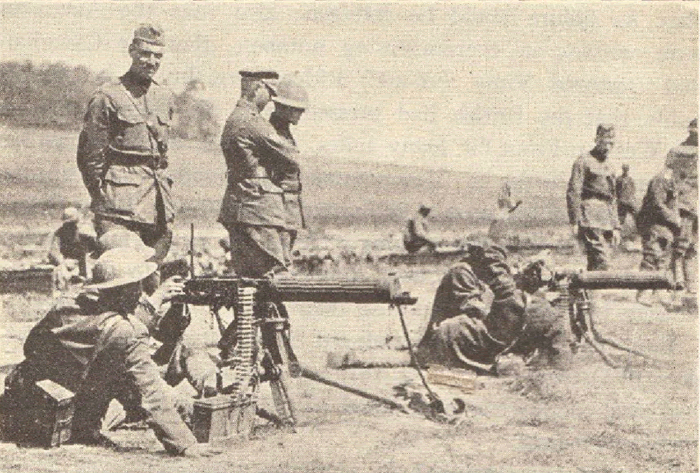Machine Guns of World War I |
| www.studenthandouts.com > U.S. History > War, Prosperity, & Depression > Maps & Pictures |
|---|
Machine Guns of World War I: This picture shows American soldiers in France being instructed by a British officer in the use of a machine gun. The metal helmets worn by the soldiers were used in all the armies for protection against shrapnel. [Click on the image to enlarge it.] Machine guns played a significant and devastating role in World War I.
Defensive Weaponry: Machine guns were primarily used as defensive weapons. They were often positioned in trenches or on elevated ground to provide a defensive line against enemy infantry charges. The rapid and continuous fire of machine guns made it extremely difficult for enemy soldiers to advance across open terrain. Fixed and Mobile Machine Gun Emplacements: Machine guns were used in both fixed and mobile emplacements. Fixed machine guns were placed in fortified positions like trenches, where they could provide sustained fire. Mobile machine guns were mounted on tripods or vehicles, allowing for more flexibility in positioning. Suppressing Enemy Troops: Machine guns were highly effective at suppressing enemy troops. Their continuous fire created a "beaten zone," an area where enemy soldiers would be forced to keep their heads down to avoid being hit. This suppression hindered the movement of enemy forces and provided cover for friendly troops. Anti-Aircraft Defense: Some machine guns were adapted for anti-aircraft defense. They were used to target and engage enemy aircraft. While early attempts were not highly effective, this marked a shift toward recognizing the potential of machine guns for anti-aircraft purposes. All-Arms Support: Machine guns provided crucial support to infantry units. They were often deployed to support advancing troops by providing covering fire and suppressing enemy positions. Machine guns were particularly valuable during offensives. High Casualties: The firepower of machine guns resulted in high casualties. Battles frequently turned into stalemates as soldiers on both sides were pinned down by machine gun fire. This led to significant loss of life and made advancements across "no man's land" extremely challenging. Tactics and Strategies: The use of machine guns forced changes in military tactics and strategies. Soldiers had to adapt to the realities of modern warfare, which included finding ways to neutralize or outflank machine gun positions. New tactics, such as the use of artillery barrages and infantry tactics like the "creeping barrage," were developed to counter machine gun fire. Advancements in Machine Gun Technology: World War I saw the use of both heavy and light machine guns. The Maxim, Vickers, and Hotchkiss machine guns were some of the heavy weapons used, while the Lewis Gun and Chauchat were examples of lighter, more mobile machine guns. Technological advances in machine guns continued to evolve throughout the war. Machine guns were instrumental in shaping the nature of World War I battles, characterized by trench warfare and high casualties. Their devastating impact on the battlefield led to a recognition of the need for new tactics and technologies in subsequent conflicts. |
 |
|---|
| www.studenthandouts.com > U.S. History > War, Prosperity, & Depression > Maps & Pictures |
|---|












